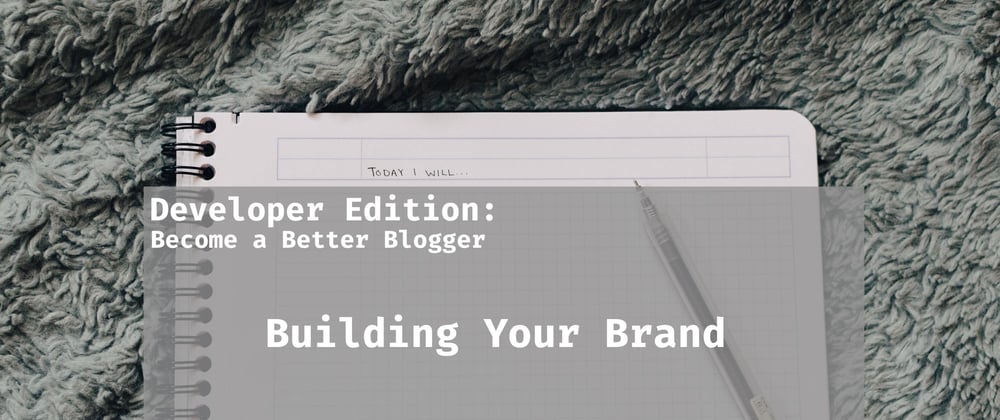Many developers have a blog. Some blogs are out there collecting dust, serving as a repository for casual thoughts, code snippets, and comments, while others convey clear expertise. In the first few seconds that someone visits your blog, they will make a decision on whether they want to continue reading. It may even impact an interview or hiring decision. What first impression will you leave?
In the first article of my new series, Become a Better Blogger, I discussed 3 Tips for Developing a Blogging Habit. This article will focus on how to Build Your Brand.
The Importance of Branding
We've all used Google to find a solution to a problem. It often takes us to Stackoverflow or a blog post with a solution. If it's the latter, we may read the post, use it to implement a solution for our use case, and leave. Occasionally, we get curious and read more, navigating to other parts of the same site. Google is a great way to source new readers, but how often do readers return or visit other pages? What sparks that curiosity?
Think about the last time you visited a blog. Do you remember it? Would you return to that blog? Why or why not?
People return to blogs that provide reoccurring value.
How is reoccurring value created?
Let's start by examining how value is defined.
Value is a combination of three things:
- Your Audience
- Their Pain Points
- Your Solution
In order to generate value, you must understand your audience and their pain points, then provide a solution that addresses these pain points. Let's take a deeper dive.
The Audience
For bloggers, an audience is a group of readers that read your blog. The more focused this audience, the easier it'll be to provide valuable content to readers.
For example, you could target all developers, but then it would be rather difficult to write content that every developer would want to read.
What about all developers that write in Python? That's a little better, but it's still very broad.
What about all developers that are using Python for Data Science applications? That's more specific, and you'll still have plenty of content to write about. Even better.
Defining your audience is important. The better you know your audience, the easier it'll be for you to relate to them. If you really want to understand your audience, talk to them and find out more. What is their job like? What programming languages and frameworks do they work with? How long have they been coding?
Their Pain Points
Understanding an audience's pain points is critical. What challenges do they face on a daily basis? When do they get frustrated or angry? When do they feel joy? Examining emotional triggers can be powerful in understanding how value can be generated.
Here are some common pain points:
- things that are time-consuming
- things that are tedious and inefficient
- things that are hard to understand
- things that are risky
- things that are expensive
What pain points have you observed?
The Solution
The solution should address the pain points observed. It doesn't have to be in the form of a blog - you may discover there's actually a better solution for the pain points uncovered. Nevertheless, starting with a blog is a great way to connect with your audience and determine whether the pain point is unique to you or if it's universal.
Keep in mind, your solution doesn't need to be limited to writing even if you are starting a blog. You can consider several kinds of solutions, such as tutorials, quick tips, code snippets, illustrations, webcomics, downloadable assets, videos, memes, etc. This is a great opportunity to define a solution that combines your passions and makes blogging fun. The more you enjoy it, the easier it'll be to keep it going!
Developing Your Brand
Now that we've defined value and the 3 pieces that create value, let's take a look at how to define your brand. Your brand should ultimately represent you - the professional you...and maybe the less professional you. That's for you to decide. Regardless of how you decide to portray yourself, make sure it's authentic. People want the real you. I know - that can be hard - but it's ok to start small. Nothing has to be done all at once.
There's a lot of different factors that contribute to your brand. To keep things simple, I'll cover only two aspects in this post: Niche and Communication Style. These two work best when combined, but may also be present independently.
Niche
A niche is a specialization. With a niche, you can develop a blog that targets a clear audience, which makes it easier to define content that is valuable for your audience. If you need some help, you can use these 3 questions to narrow your focus:
- What are you currently doing professionally?
- What do you enjoy doing professionally?
- Where do you want to be professionally in 3-5 years?
These questions can serve as the foundation for defining your niche. It's important to consider where you are now so that you can work with the foundation you have to build the future you desire. It's even more important that you enjoy what you are doing, otherwise, it can be challenging to maintain.
Consider these scenarios:
Amy, full-stack engineer
Amy is a full-stack engineer working in a small company. She handles all kinds of tasks, ranging from databases to microservices design to user interface development. After tackling all these tasks, she realizes she enjoys automating and deploying applications the most. She aspires to become a remote Cloud Engineer so that she can work from home on the beachfront. She decides to focus her blog on sharing her latest accomplishments and to demonstrate her recipes for optimizing cloud deployments.
Marcus, front-end engineer
Marcus is a front-end engineer working in a large firm. He develops user interfaces and data visualizations for various internal customers. He discovers that he enjoys working with data and visualizing data. In a few years, he sees himself as a data engineer, working directly with large datasets and developing complex data visualizations to uncover insights to complex questions. He decides to focus his blog on sharing use cases for different types of visualizations and his journey on becoming a data engineer.
What's your story?
Communication Style
Your blog should reflect a distinct communication style. If you have been working on developing a writing habit by journaling, you may notice patterns in your writing.
Do you write a lot or a little? How often do you write? Does it vary (do you write a lot on some days and a little on others)? What personality shines through your writing?
Even if you write a little, that's ok - as long as you start. It gets easier with time. And, just because you write a little doesn't mean you can't add value. There's always more than one way to communicate. Images, videos, and webcomics are also an option. Some of these options may suit your communication style better.
You can also use this opportunity to bring in other passions. Brainstorm some ideas and think of ways you can tie it all together. For example, maybe you're passionate about cooking. You could develop coding samples using a cooking theme.
What are your passions? How can you incorporate your passions into your knowledge sharing process? What media format can you use to share your knowledge?
Putting Everything Together
To recap, we've covered value creation through understanding your audience, understanding their pain points, and providing a solution for that audience that relieves their pain. Afterward, we looked at building a brand by defining a niche and a communication style.
You can develop your brand first, by identifying your niche and communication style, before tackling value creation, or decide how you want to create value then define your brand. There will be some overlap between the two. Start with whichever is easiest for you.
Spotlight
For inspiration, take a look at these developer/programming blogs:
- Ahmad Awais, Developer Advocate
- Tania Rascia, Web Development Journey
- a11y with Lindsey, Web Accessibility
Until Next Time
Share what you've come up with and let me know if you have any questions. In my next post, I'll discuss developer-friendly blogging platforms and provide some tips to decide how to host your blog.
I've always enjoyed writing, though it was often creative writing that consumed my free time. Lately, I've become pretty interested in incorporating writing into my daily lifestyle in a technical and non-technical capacity. I've been researching writing, copywriting, content marketing, habit building, productivity hacks, and similar topics to accomplish this. If you're interested in learning more about developing a writing habit, follow me for more tips and insights.
And, if there's anything I can do to help, feel free to reach out. 🙂
Additional Resources
The canvas linked below is often used for creating new products. If you're thinking of developing a product, it's a worthwhile exercise. I've applied it to content creation for blog writing.







Oldest comments (3)
Great tips Rachel, love the customer focus
found it really Insightful !!
I also think the use of images and icons will also make the blog posts more attracted. People tends to see the images quicker, and they will read your content more if there are "enough" images.